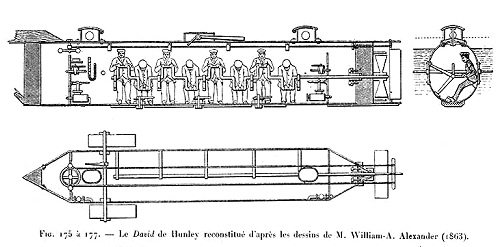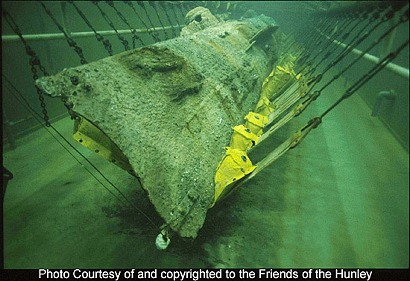|
|
T
oday we have many sophisticated
weapons such as the world as never seen. We have stealth bombers and many of our
navy ships contain some sort of stealth technology. So it might be amazing to
some people that there was a stealth weapon used nearly 150 years ago in the American
Civil War.
Many historians agree that the Confederate navy was the
first to use a submarine to sink an enemy ship. That’s exactly what happened on
a cold February night in 1864 when a little vessel known as the H.L.
Hunley submerged and attached a torpedo-like device to the U.S.S. Housatonic
and blew it up. There’s little doubt that in those times a submarine would certainly
have been considered a stealth weapon. |
 |
The Union had a blockade
in place around the port of Charleston, South Carolina, and it was from
that harbor that the little Hunley departed in search of an enemy ship. With eight
men aboard, the commander of the Confederate submarine, Lt. George Dixon,
had orders to attack any Union vessel he might encounter.
And although
their mission had been accomplished, the men in the Hunley never returned to receive
the gratitude and laurels that would have no doubt been heaped upon them for their
heroic accomplishment. It is believed that the Hunley sank during its attack on
the Housatonic or shortly thereafter. |
 |
The
men in the little submarine all died in the attack, but because of their previously
unheard-of actions beneath the sea, they will forever be remembered for beginning
a phase in naval warfare that continues to progress with new innovations and larger
and more powerful submarines.
There is no doubt that the Hunley was a
deathtrap to operate. The men had to crawl through a 4-foot-tall passageway just
to get to their places on a long, low bench. Each of them sat down at a hand crank
attached to the Hunley’s propeller shaft. The ship was completely powered by the
hands of the crew.
The narrow top-secret submarine, built in Mobile,
Alabama, by Horace Hunley from cast iron and wrought iron with a hand-cranked
propeller, arrived in Charleston in 1863 while the city was under siege by Union
troops and ships.
The Hunley sank twice in sea-trial accidents, killing
13 crew members including its namesake, Horace Hunley. The Confederate navy hauled
the sub up twice and recovered the bodies of the crew. But because of its innovative
characteristics, the Confederates didn’t give up on the little vessel and stuck
with their plan to use it to attack Union ships.
Thanks
to the dedicated effort of many determined individuals, the Hunley was found in
1995 and raised in 2000. After it was recovered, a partnership was formed by those
interested in restoring the Hunley. Aptly named “The Hunley Project,” the
group had spent more than $22 million on the restoration through 2010.
According
to Michael Drews, director of Clemson’s Warren Lasch Conservation Center, scientists
have found the vessel to be a more sophisticated feat of engineering than historians
had thought. “It has the ballast tanks fore and aft, the dive planes were counterbalanced,
the propeller was shrouded,” Drews said. “It’s just got all of the elements that
the modern submarines have, updated.”
Drews said there had been previous
submarines, but the Hunley was designed to sail in the open ocean and built for
warfare – that was cutting-edge technology at the time.
Recently, for
the first time since it was recovered, people were treated to an unobstructed
view of the 42-foot-long submarine after a massive steel truss that had been covering
the top of the Hunley was removed capping 10 years of careful preservation.
From
the time it was brought to the surface over a decade ago, the submarine has been
kept in a 90,000 gallon tank of fresh water to keep it from rusting.
It’s
interesting to note that most of the men aboard the Hunley weren’t even from the
South. Forensic scientists believe four of the men were from northern Europe.
One of the crew was from Maryland, a slaveholding state that didn’t secede from
the United States when the Civil War erupted in 1861.
Only two crewmen
were from slaveholding states and George Dixon – who led the Hunley on its historic
but doomed mission and became an immortal hero of the Confederacy – was from Ohio
where slavery was illegal.
© Murray
Montgomery February
10, 2012 column
More
Lone
Star Diary
Related
Topics:
Texas | Texas
Black History | WWII
| WWI | Columns
| |
|
| Book Hotels
- Expedia
Affiliate Network | |